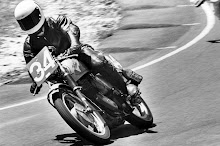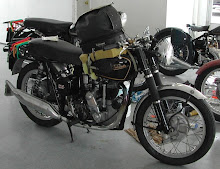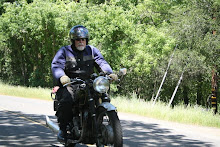I illustrated it with a French Jaeger tacho on Roger Loyer's 1933 KTT Velocette during the IOM Junior TT, but Andrew Rachstraw found a 1922 photo from Brooklands with a 494cc Douglas using what looked like a Smiths governor instrument clipped to the handlebar... well I searched though my 1919-20 and 1924 Smiths catalogues featuring the governor speedo and tacho...the only type Smiths offered at that time as it was not until the late 1920's they acquired the rights to make the chronometric from Jaeger (Paris) by purchasing the newly formed UK, Jaeger E.D. ( and renaming it British Jaeger around 1930). And there was the tacho drive..as illustrated and the tacho, obviously with likely a special dial face made probably to around 6000rpm. Illustrated is a dial from my master catalogue of when I printed dials for a 5000rpm gnvr tacho, My artwork was done from an original dial I had.
Roger Loyer astride his 1933 KTT Velocette at the IOM TT races of that year... the Jaeger tachometer is visible mounted low down near the front of the petrol tank and it is driven by a bronze tacho drive from the bottom magneto chain sprocket...
T.Eve on his 494cc Douglas in 1922 at Brooklands, UK...the tachometer is a Smiths governor principle tacho, unsure of the ratio or dial scale...
The tacho drive from a 1919-20 Smiths catalogue....
Tachometers from the 1919-20 Smiths catalogue...the latter mounting is for a car and attaches to the car dashboard.
Illustration of the internals of the Smiths governor instrument showing the rotor which operates in the same way as a steam governor...the weights swing out as the cable speed increases and the collar at the top of the rotor moves down, and via a rocker arrangement swings the pointer around the dial face.
Above is an original Smiths governor dial face from the 1920's ...and the scale is non linear, which is a characteristic of the Smiths governor instrument. It makes calibration difficult.




















No comments:
Post a Comment